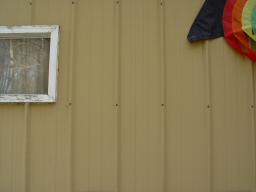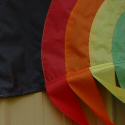When a 180-degree fish-eye lens is not a 180-degree fish-eye lens.
Just looking at the photos of this lens online, I was already suspicious that this lens couldn't possibly cover a full 180-degree light path. The front element is very nearly flat (just a very slight convexity to it). No well-behaving light-ray in this universe would dare call itself respectable in the morning if it tried to diffract that far through this lens. While it's not 180-degrees, it comes close. At best it's about 175-degrees. But I think it's more like a 168 to 170-degree field of view or just a degree or two under that. Below is a close-up of a protractor with the front edge of it touching the front lens surface (handheld in dim light, don't use this example for image quality). Note too that there's about a 5mm distance from the near edge to the center point of the protractor. If you look close and count off the 10-degree markings on the protractor you'll see that the field-of-view stops at about 172-175-degrees on either side. Subtract that short 5mm distance to the center and that averages near the 170-degree mark. Still though, that's an impressive performance from such a flat hunk of glass. Perhaps with other camera lens makes and models that their claims of 180+ degrees can hold true, but I sincerely doubt it -- in another universe that has different laws of physics maybe, but not this one.



